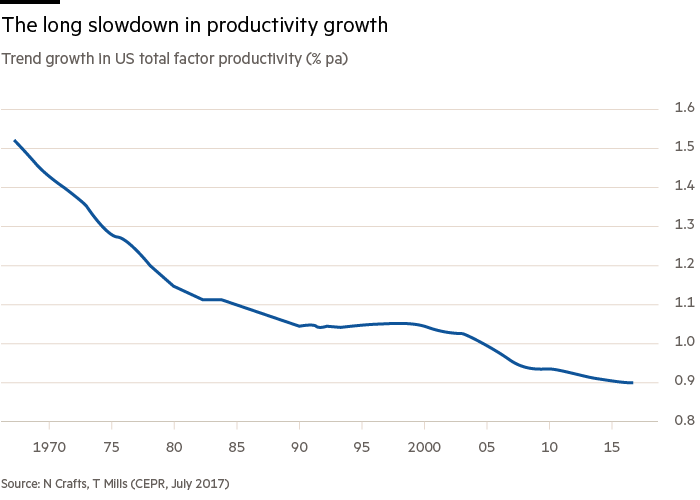Latest news about Bitcoin and all cryptocurrencies. Your daily crypto news habit.
 Photo by Uillian Vargas on Unsplash
Photo by Uillian Vargas on Unsplash
The conditions are ripe and have been ripe for some time, for strong productivity growth across the world.
First, Scrum and Agile approaches have been with us for 20 years, and as Jeff Sutherland wrote in Scrum, The Art of Doing Twice the Work in Half the Time, unlock vast productivity increases across teams and organisations.
Scrum teams that work well are able to achieve what we call ‘hyperproductivity’. It’s hard to believe, but we regularly see somewhere between a 300- to 400-percent improvement in productivity among groups that implement Scrum well. The best teams can achieve productivity increases of up to 800 percent and replicate that success over and over again. They also end up more than doubling the quality of their work.
Second, software is all pervasive. Software touches everything and anything. Across the world, at pace, organisations and industries are becoming ‘digital’. While it’s not since 2011 that Marc Andreessen wrote Why Software Is Eating the World, and two years since Tech Crunch reminded us Software is still eating the world, we can all pretty much see that we live in a software dominated world.
Today, the idea that “every company needs to become a software company” is considered almost a cliché. No matter your industry, you’re expected to be reimagining your business to make sure you’re not the next local taxi company or hotel chain caught completely off guard by your equivalent of Uber or Airbnb.
So in a software centric world, with a mature technique that accelerates the productivity of delivering software between 4- and 8–fold, the potential for the global economy is incredible. We should be swooning at the productivity figures — but it’s not quite working out like that.
What’s really going on is quite different.
You can see the computer age everywhere but in the productivity statistics.
This could have been written today, but is a quote from 1987 by Robert Solow, the American Economist and founder of modern growth theory.
The Financial Times commented on this in their article The long wait for a productivity resurgence, and the graph they used to illustrate the point makes sobering viewing.

In a software based world, with 20 years of modern practices that deliver software faster and more effectively than ever, productivity has tanked.
So what’s gone wrong?
Theorem 1 — Agile can deliver but is being impeded by off beat adoption— chief culprit: leadership
We know adopting Agile practices helps teams accelerate and gain momentum — we’ve seen it first hand. Teams that check in to see if there are ways to improve and do things better, and check what might be keeping them from doing that — in an “Inspect and Adapt” cycle, applied with discipline in the right team, can unleash speed and delivery of value.
Added to this, while agile practices were typically focused on software development teams, these days DevOps broadens the field to incorporate the operations and support environment, further reducing lag and rework in delivering value, and reducing lead times.
If these practices increase in prevalence, as software itself increases in prevalence, productivity and output per person goes up across the world. Agile is not the problem, but leadership of Agile is.
Leading agile demands a different skillset from leaders. It demands different leaders.
The world has changed fast, and where the old world of “command and control” used to be acceptable — go away and do this and come back to tell me when you’ve done it — the move from a team that needs closer support (or scrutiny and micromanagement to some) to a team that can look after itself, has caught many off guard. Agile teams need to be exactly that, agile. The overhead can be reduced, and in place of managers and micro managers, we need a new type of leader. Servant leaders, who understand how to empower teams, have a service mindset and are in tune with unleashing team potential, and understanding the sweet spot between flow, quality, value, and team wellbeing.
In organisations and teams far and wide, a skewed agile is being implemented and imposed on teams. Teams are told to adopt someone else’s framework and methods. The managers are not trained up, do not buy in and as a result are getting it wrong, creating a block point and preventing the potential productivity gains.
Theorem 2— Agile is being well led and delivering left, right and centre, but the productivity gains are masked by greater macroeconomic factors
Contrary to above, Agile by and large is being well led. Agile adoption is prevalent and in keeping with first principles. The 12th Annual State of Agile Report paints a reasonably positive picture, although I struggled finding real metrics on where organisations started and where they ended up.
But there are bigger things at play which on a macroeconomic level mask all these four and eight-fold improvements we’re seeing across global software teams.
Other factors such as diminished competition, asset bubbles and economic crises, protectionism and trade wars, could be masking the gains under the hood. Or worse, as the FT writes, “the technology innovations of the modern day, may simply not be what they are claimed to be, particularly compared with the wide range of transformative ones from the late 19th and early 20th centuries: clean water, electricity, the internal combustion engine, powered flight, petroleum and chemicals.” Or, we are in the quiet before the storm, where technologies such as Artificial Intelligence are about to unleash break-through productivity the like of which the world has never seen.
Either way, it makes interesting thought. How do our innovations and technology breakthroughs compare to what went before? Do we have the right leadership and practices in places to deliver these breakthroughs in the best possible way?
Software is everywhere. Agile helps us deliver it faster. But global productivity lags. So what gives?
If you have measures and evidence of agile delivering breakthrough productivity gains, I’d love to hear about them. Or if you have examples of it failing, it would be interesting to hear your thoughts as to the cause, leadership or otherwise.
Or it could be that things are rosy, and we’re about to have lift off.
 Photo by Nicolas Gras on Unsplash
Photo by Nicolas Gras on Unsplash
An article inspired by and written in conjunction with Harvey Neve.
Gary Watts and Harvey Neve
If you enjoyed this article please share and hit 👏👏 👏.
What’s getting Agile down? was originally published in Hacker Noon on Medium, where people are continuing the conversation by highlighting and responding to this story.
Disclaimer
The views and opinions expressed in this article are solely those of the authors and do not reflect the views of Bitcoin Insider. Every investment and trading move involves risk - this is especially true for cryptocurrencies given their volatility. We strongly advise our readers to conduct their own research when making a decision.
